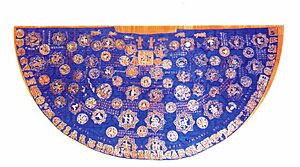Melus of Bari facts for kids
Quick facts for kids
Melus
|
|
|---|---|
| Duke of Apulia | |

Cape gifted to Holy Roman Emperor Henry II by Melus
|
|
| Duke of Apulia | |
| Reign | 1015-1020 |
| Predecessor | title created |
| Successor | title vacant Next Duke of Apulia: Guaimar IV of Salerno |
| Died | 1020 |
| Spouse(s) | Maralda |
| Issue | Argyrus |
Melus (also known as Milus or Melo) was a nobleman from the city of Bari in Apulia, Italy. He lived in the early 1000s. Melus wanted to create his own independent land, free from the control of the Byzantine Empire. The Byzantines were a powerful empire that ruled parts of Italy at that time. Melus's fight for freedom accidentally led to the arrival of the Normans in Southern Italy. The Normans were a group of people from northern Europe who became very important in Italy. Melus was also the first person to be called the Duke of Apulia.
Melus's Early Rebellions
Melus and his brother-in-law, Dattus, started a rebellion in 1009. They quickly took control of their hometown, Bari. In 1010, they also captured the towns of Ascoli and Troia.
However, a new Byzantine leader, called a catapan, named Basil Mesardonites, gathered a large army. On June 11, 1011, Bari was recaptured by the Byzantines. Melus had to flee for safety. He found protection with Prince Guaimar III of Salerno. Dattus went to a monastery called Montecassino. The monks there, who didn't like the Byzantines, gave Dattus a strong tower to hide in. Sadly, Melus's family was captured and sent far away to Constantinople, the capital of the Byzantine Empire.
Asking for Norman Help
In 1016, Melus decided to try again. He went to a famous holy place called Monte Gargano. There, he met some Norman travelers who were on a religious journey. Melus asked a Norman leader named Rainulf Drengot and his group of Norman exiles for help. He promised them that victory would be easy and they would get lots of treasure.
By 1017, many Norman adventurers were traveling south to Italy. They joined forces with Melus and his Lombard (Italian) fighters near Capua. Together, they marched into Apulia, hoping to surprise the Byzantines.
Battles and Defeat
In May 1017, Melus and the Normans won a battle near the Fortore River against the Byzantine forces. They managed to take control of all the land between the Fortore River and the city of Trani by September. They were causing a lot of trouble in Apulia.
However, in October, things went very wrong for them. A new Byzantine catapan named Basil Boioannes arrived. He had a huge army, including a special group of elite soldiers called the Varangian Guard. These guards were famous warriors from the Byzantine Emperor Basil II's personal army.
The Byzantines met the Normans and Lombards at the Ofanto River. This was the same place where the Romans had suffered a terrible defeat against Hannibal long ago. This second battle of Cannae in 1018 was a disaster for Melus and his allies. The Normans lost their leader, Gilbert. Melus and Dattus had to run away. Melus fled to the Papal States, and Dattus returned to his tower at Montecassino.
Melus's Final Years
After the defeat, Melus kept moving around southern and central Italy. Eventually, he traveled north to Germany. He ended up at the court of the Holy Roman Emperor Henry II in Bamberg.
The Emperor honored Melus greatly and even gave him the title of Duke of Apulia. However, Melus was heartbroken by his failures. He died just two years later, in 1020. His death happened shortly after Pope Benedict VIII came to Bamberg to discuss how to respond to the Byzantine victories. Melus was given a grand funeral and a beautiful tomb in the new Bamberg Cathedral by his old friend, the Emperor.
Melus's son, Argyrus, would later continue the fight for Lombard independence in Apulia after he was released from prison in Constantinople.

